

Physics - Sub-Atomic Particles etc twitter. Electrons are fantastically round, say British scientists. After three months of experiments in a basement laboratory in London, scientists can confirm – with more confidence than ever – that the electron is very, very round.

Electron is surprisingly round, say scientists following 10 year study. (PhysOrg.com) -- Scientists at Imperial College London have made the most accurate measurement yet of the shape of the humble electron, finding that it is almost a perfect sphere, in a study published in the journal Nature today.

The experiment, which spanned more than a decade, suggests that the electron differs from being perfectly round by less than 0.000000000000000000000000001 cm. This means that if the electron was magnified to the size of the solar system, it would still appear spherical to within the width of a human hair. The physicists from Imperial's Centre for Cold Matter studied the electrons inside molecules called Ytterbium Fluoride. Using a very precise laser, they made careful measurements of the motion of these electrons. Challenge to everyday physics... Gharr: I think this #spherical_el... Supersymmetry. Round-electron challenge to mainstream physics. At last the cautious BBC voices physicists’ majority view that Gravity is not explained by the “Standard Model” of physics (Pallab Ghosh 25 May 2011) – meaning ‘gravitons’ are unreal – in an offhand comment on the electron-is-round story.
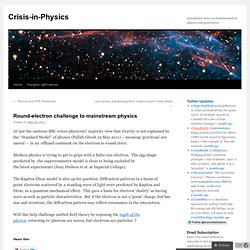
Modern physics is trying to get to grips with a finite size electron. The egg-shape predicted by the supersymmetry model is close to being excluded by the latest experiments (Jony Hudson et al. at Imperial College). The Kapitsa-Dirac model is also up for question. Diffraction patterns in a beam of point electrons scattered by a standing wave of light were predicted by Kapitsa and Dirac, as a quantum mechanical effect. This gave a basis for electron ‘duality’ as having wave as well as particle characteristics.
Will this help challenge unified field theory by exposing the myth of the photon, returning to ‘photons are waves, but electrons are particles’ ? Like this: Like Loading... 9812011v2. Graviton. Theory[edit] The three other known forces of nature are mediated by elementary particles: electromagnetism by the photon, the strong interaction by the gluons, and the weak interaction by the W and Z bosons.
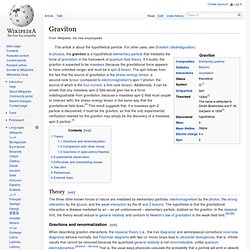
The hypothesis is that the gravitational interaction is likewise mediated by an – as yet undiscovered – elementary particle, dubbed as the graviton. In the classical limit, the theory would reduce to general relativity and conform to Newton's law of gravitation in the weak-field limit.[6][7][8] Gravitons and renormalization[edit] When describing graviton interactions, the classical theory (i.e., the tree diagrams) and semiclassical corrections (one-loop diagrams) behave normally, but Feynman diagrams with two (or more) loops lead to ultraviolet divergences; that is, infinite results that cannot be removed because the quantized general relativity is not renormalizable, unlike quantum electrodynamics.
Comparison with other forces[edit] Gravitons in speculative theories[edit] See also[edit] Graviton. Theory[edit]
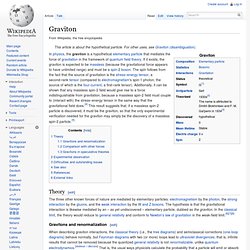
Gravity, Branes And Hidden Dimensions Graviton THEORIES OF THE BRANE. The high concentration of the graviton near the brane—let's call the brane where gravity is localized the Planck brane—leads to a natural solution to the hierarchy problem in a universe with two branes.
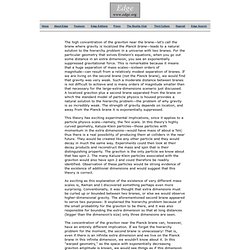
For the particular geometry that solves Einstein's equations, when you go out some distance in an extra dimension, you see an exponentially suppressed gravitational force. This is remarkable because it means that a huge separation of mass scales—sixteen orders of magnitude—can result from a relatively modest separation of branes. If we are living on the second brane (not the Planck brane), we would find that gravity was very weak. Such a moderate distance between branes is not difficult to achieve and is many orders of magnitude smaller than that necessary for the large-extra-dimensions scenario just discussed. This theory has exciting experimental implications, since it applies to a particle physics scale—namely, the TeV scale. It's an exciting but frustrating game. Other dimension gravitons as the dark matter source. The Question (Submitted July 26, 2006) Since string theory implies up to 11 dimensions, could dark matter be gravitons leaking from other dimensions into ours?
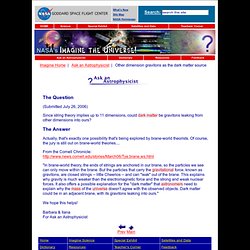
The Joy of Gravitons, Hyperspace, Branes and Brainstorms. In addition to the incredulity of their colleagues, Dr.
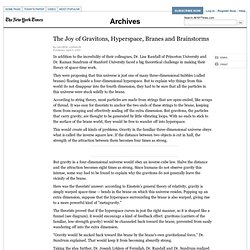
Lisa Randall of Princeton University and Dr. Raman Sundrum of Stanford University faced a big theoretical challenge in making their theory of space-time work. They were proposing that this universe is just one of many three-dimensional bubbles (called branes) floating inside a four-dimensional hyperspace. But to explain why things from this world do not disappear into the fourth dimension, they had to be sure that all the particles in this universe were stuck solidly to the brane. According to string theory, most particles are made from strings that are open-ended, like scraps of thread. This would create all kinds of problems. But gravity in a four-dimensional universe would obey an inverse cube law. Here was the theorists' answer: according to Einstein's general theory of relativity, gravity is simply warped space-time -- bends in the brane on which this universe resides. Membrane (M-theory) In string theory and related theories, D-branes are an important class of branes that arise when one considers open strings.
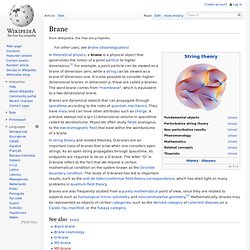
As an open string propagates through spacetime, its endpoints are required to lie on a D-brane. Spherical Electron Field. Z)))): See this thread, top comme... After a 10 year study Scientists find the shape of the Electron to be 'Fantastically Round'. Article published in Nature today. Could be the start of new physics. : Physics. Really about testing beyond Standard Model predictions of large dipole moments of the electron : Physics.